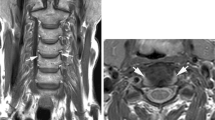Summary
Nine patients with severe and prolonged signs and symptoms due to cervical spondylosis had myelography followed by a CT Scan using the same injection of intrathecal contrast. All patients had radiographic changes of cervical spine degeneration and were being considered for exploration and fusion of the anterior cervical spine. All patients had a full clinical evaluation, EMG studies and plain radiographs taken prior to their CT Scan. EMG readings showed several levels of compression in three patients but did not indicate a single level in any. Plain radiography showed multiple level involvement in every patient. Myelography indicated significant indentation in three of five patients with clinical signs but did not demonstrate root cut off in any case. CT Myelography indicated the degree of Lushka and facet joint involvement, indentation, exit foramen encroachment, and the degree of spinal stenosis at the involved segment. In three patients, the findings at operation correlated closely with the CT Scans. Myelography failed to indicate the presence of significant osteophytes in these two cases.
Résumé
Neuf cas d'arthrose cervicale, à l'origine de symptômes sévères et prolongés, ont été étudiés par myélographie couplée à un examen tomodensitométrique en utilisant la même injection de produit de contraste. Dans tous les cas existaient des signes radiologiques de cervicarthrose et les patients étaient programmés pour un abord antérieur du rachis cervical en vue d'une arthrodèse intersomatique. Tous avaient un bilan clinique, électromyographique et radiographique complet avant l'examen tomodensitométrique. L'examen électromyographique a permis dans trois cas de mettre en évidence l'atteinte de plusieurs étages. De même l'examen radiographique a toujours montré une atteinte pluriétagée. La myélographie a visualisé une compression du sac dural dans trois cas sur cinq mais sans jamais révéler l'absence d'injection d'une racine nerveuse. Lorsque la myélographie était couplée à un examen tomodensitométrique les renseignements étaient plus précis: atteinte des articulations de Lushka et interapophysaires, existence d'une compression centrale et/ou latérale. Dans trois cas les constatations opératoires ont confirmé les données de la tomodensitométrie alors que la myélographie seule n'avait pas montré la présence d'importants ostéophytes.
Similar content being viewed by others
References
Brain WR (1963) Some unsolved problems of cervical spondylosis. Br Med J 1: 771–777
Brunton FJ, Wilkinson JA, Wise KSH, Simonis RB (1982) Cine radiographs in clinical spondylosis as a means of determining the level for anterior fusion. J Bone Joint Surg [Br] 64: 399–404
Cloward RB (1963) Lesions of the intervertebral discs and their treatment by interbody fusion. Clin Orthop Relat Res 27: 51–77
Coin CG, Coin JT (1981) Computed tomography of cervical disc disease: technical considerations with representative case reports. J Comput Assist Tomogr 5: 275–279
Di Chiro G, Schellinger D (1976) Computed tomography of spinal cord after lumbar intrathecal introduction of metrizamide (Computer assisted myelography). Radiology 120: 101–104
Fielding JW (1957) Cineroentgenography of the normal cervical spine. J Bone Joint Surg [Am] 39: 1280–1288
Fielding JW (1964) Normal and selective abnormal motion of the cervical spine from the second cervical vertebral to the seventh cervical vertebral based on cineradiography. J Bone Joint Surg [Am] 46: 1779–1782
Kaufman B (1983) Metrizamide-enhanced computed tomography and newer techniques of myelography. Contributions of the Cervical Spine Research Society of USA. J. B. Lippincott, Philadelphia, pp 103–111
Kikuchi S, Macnab I, Moreau P (1981) Localisation of the level of cervical disc degeneration. J Bone Joint Surg [Br] 63: 272–277
Seibert CE, Barnes JE, Dreisback JN, Swenson WB, Heck RJ (1981) Accurate CT measurement of the spinal cord using metrizamide; Physical factors. Am J Radiol 136: 77–780
Shea AP, Woods WW, Werden CH (1950) Electromyography in diagnosis of nerve root compression syndrome. Arch Neurol Psychiatry 69: 93–104
Smith GW, Robinson RA (1958) The treatment of certain cervical spine disorders by the anterior removal of the intraventrical disc and interbody fusion. J Bone Joint Surg [Am] 40: 607–623
Yu YL, Steven JM, Kendal B, du Boulay GH (1983) Cord shape and measurement in cervical spondylotic myelopathy and radioculopathy. Am J Neuroradiol 4: 839–842
Author information
Authors and Affiliations
Rights and permissions
About this article
Cite this article
Boot, D.A., Khan, R.H., Sellar, R.J. et al. Computed tomogram myelography in cervical spondylosis. International Orthopaedics 11, 249–254 (1987). https://doi.org/10.1007/BF00271457
Issue Date:
DOI: https://doi.org/10.1007/BF00271457




